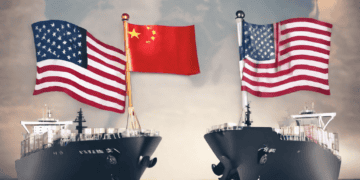The signing of the US-China Economic and Trade Agreement on January 15, 2020, marked a significant moment in the ongoing trade disputes between the two global economic powerhouses. Following months of intense negotiations and escalating tensions, both nations agreed on a preliminary deal aimed at de-escalating their trade war.
This initial agreement, while celebrated as historic by the signing parties, primarily focuses on immediate enforceable actions related to tariff rollbacks, increased trade purchases, and renewed commitments on intellectual property rights, technology transfer, and currency practices. However, the deal’s ambitious goals are met with skepticism regarding long-term viability and effectiveness.
The signing ceremony at the White House saw US President Donald Trump and Chinese Vice President Liu He emphasizing the importance of the agreement as a step towards fair and reciprocal trade, highlighting hopes for a resolution of their differences through dialogue.
Despite the relief felt across industries due to the cessation of further escalations, the agreement leaves several underlying issues unresolved. Notably, China’s stance on industrial subsidies remains a key concern, while previous tariffs persist despite some rollbacks. The potential for future negotiations is influenced by political considerations, notably the US presidential election at the time and ongoing assessments of national interests.
The deal consists of eight chapters covering intellectual property rights, technology transfer, agriculture, financial services, foreign exchange, trade expansion, dispute resolution, and final provisions. Key elements include:
- Tariff Rollback: The agreement cancels certain tariffs and commits to reducing others, yet significant tariffs remain in place, awaiting potential resolution in a subsequent phase.
- Trade Expansion: China pledged to purchase an additional $200 billion worth of US goods and services over two years, focusing on various sectors like manufactured goods, agriculture, energy, and services.
- Intellectual Property: The agreement addresses concerns related to trade secrets, patents, trademarks, and enforcement against counterfeit goods. It emphasizes protection for confidential information and pharmaceutical-related intellectual property.
- Technology Transfer: Both parties agreed to ensure voluntary technology transfer between companies without external pressure, aiming to prevent distortion in sectors and industries.
- Financial Services: China promised improved market access for financial services, agreeing to remove foreign ownership caps on securities firms and enhance opportunities in banking, insurance, and asset management.
- Currency: Provisions discourage currency manipulation and require transparent disclosure of foreign exchange reserves and trade data.
- Dispute Resolution: Mechanisms for resolving disputes involve bilateral consultations and the possibility of imposing tariffs or other punitive measures if negotiations fail.
Despite the positive outlook for some industries, concerns remain about the practicality of China meeting its increased purchase commitments, potential market disruptions, and the broader implications for global trade relationships. The persistent tariffs contribute to uncertainty for businesses, leading some multinational firms to relocate operations to other countries.
For Chinese enterprises, particularly in the technology sector, the trade war has prompted a reevaluation of their reliance on US markets and suppliers, fostering a shift towards alternative markets and suppliers in emerging economies.
While the phase one deal marks a crucial milestone in US-China trade relations, its success and impact on businesses hinge on how both parties navigate the complex provisions and unresolved issues, alongside evolving global trade dynamics and efforts to reform trade regulations.
The phase one trade deal has set a significant precedent for future negotiations and global trade dynamics. Its success or shortcomings will undoubtedly shape the course of US-China relations and influence trade patterns across various industries. However, the deal’s intricacies and potential consequences necessitate a closer examination to understand its full impact on businesses and economies.
For American businesses, the deal offers some relief from the uncertainties of the trade war, particularly through tariff reductions and the potential for increased exports to China. Yet, challenges persist, especially regarding the practicality of China’s commitments and the broader geopolitical landscape.
The trade war’s effects have prompted many businesses, both in the US and China, to reassess their supply chains, diversify their markets, and seek alternative strategies to navigate the uncertainties arising from the ongoing disputes. This trend has led to a shift in global trade dynamics, with emerging economies gaining increased attention as potential trade partners and investment destinations.
Moreover, the trade deal’s impact extends beyond bilateral relations between the US and China. It has spurred discussions on reforming international trade rules, particularly within the World Trade Organization (WTO), as highlighted by proposals from the US, Japan, and the European Union to address inadequacies in dealing with market-distorting subsidies.
The deal’s success hinges not only on the enforcement of its provisions but also on the evolving geopolitical landscape, domestic policy priorities in both nations, and the changing dynamics of global supply chains. Furthermore, the uncertainty surrounding the deal’s longevity, especially with subsequent phases and potential changes in leadership, adds another layer of complexity to its assessment.
As businesses adapt to the new trade environment shaped by the phase one deal, strategic planning and flexibility will be essential. Companies need to remain agile, diversify their operations, and explore new markets while closely monitoring developments in US-China relations and global trade policies.
The long-term implications of the trade deal remain uncertain, as its effectiveness in resolving deep-rooted issues and fostering a stable trade relationship between the US and China is yet to be fully realized. Businesses must remain vigilant and responsive to changing dynamics, ensuring resilience amid geopolitical uncertainties and evolving trade landscapes.
The phase one trade deal serves as a critical chapter in the ongoing saga of US-China trade relations. Its impact on businesses, economies, and global trade dynamics underscores the need for continued analysis and adaptation to navigate the complexities and uncertainties of the modern global market.
Your source for supply chain report news updates: The Supply Chain Report. For international trade insights and tools, head to ADAMftd.com.
#USChinaTradeDeal #EconomicAgreement #TariffRollback #TradeExpansion #IntellectualProperty #TechnologyTransfer #FinancialServices #CurrencyProvisions #DisputeResolution #GlobalTrade #PhaseOneDeal #TradeWarImpact #USChinaRelations #SupplyChainShifts #EmergingMarkets #GeopoliticalUncertainty #WTOReform #BusinessStrategy #GlobalSupplyChains #USExports #ChinaCommitments #InternationalTradeRules #MarketAccess #ExportOpportunities #ChinaPurchasesUSGoods

















